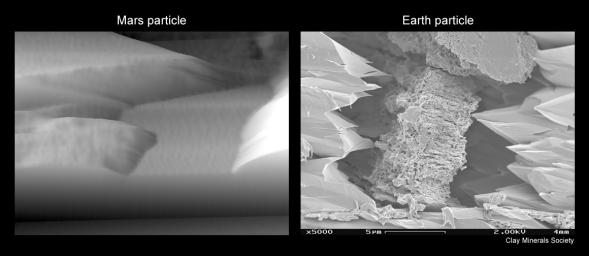Mars Particle and Terrestrial Soil, Compared Microscopically
Caption:
The image on the left is a particle of Martian soil observed with the atomic force microscope on NASA's Phoenix Mars Lander. For comparison, the image on the right is a type of terrestrial soil viewed with a scanning electron microscope.
The Mars image covers an area approximately 10 microns wide. This flat, smooth-surfaced particle is consistent with the appearance of soil particles from Earth containing the mineral phylloslicate, as seen in the left and right perimeter of the terrestrial image.
The terrestrial image shows particles in a soil sample from Koua Bocca, Ivory Coast, West Africa. This image's field of view is approximately 23 microns wide.
Mars image credit:
NASA/JPL-Caltech/University of Arizona/University of Neuchatel/Imperial College London
Earth image credit:
Photo courtesy of Michael Velbel (Michigan State University) and William Barker, (University of Wisconsin-Madison). From the image database of the Clay Minerals Society and the Mineralogical Society of Great Britain and Ireland at
http://www.minersoc.org/pages/gallery/claypix/index.html
.
Background Info:
The Phoenix Mission is led by the University of Arizona, Tucson, on behalf of NASA. Project management of the mission is by JPL, Pasadena, Calif. Spacecraft development was by Lockheed Martin Space Systems, Denver.
Photojournal Note:
As planned, the Phoenix lander, which landed May 25, 2008 23:53 UTC, ended communications in November 2008, about six months after landing, when its solar panels ceased operating in the dark Martian winter.
Cataloging Keywords:
| Name |
Value |
Additional Values |
| Target |
Mars |
|
| System |
|
|
| Target Type |
Planet |
|
| Mission |
Phoenix |
|
| Instrument Host |
Phoenix Lander |
Phoenix Mars Lander |
| Host Type |
Lander |
|
| Instrument |
Microscopy, Electrochemistry, and Conductivity Analyzer (MECA) |
|
| Detector |
|
|
| Extra Keywords |
Grayscale |
| Acquisition Date |
|
| Release Date |
2008-09-30 |
| Date in Caption |
|
|
| Image Credit |
NASA/JPL-Caltech/University of Arizona |
| Source |
photojournal.jpl.nasa.gov/catalog/PIA11206 |
| Identifier |
PIA11206 |

 Planetary Data System
Planetary Data System
